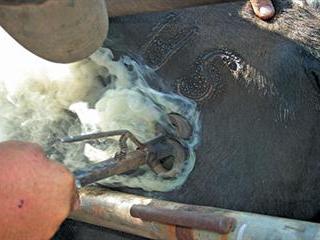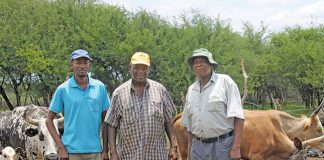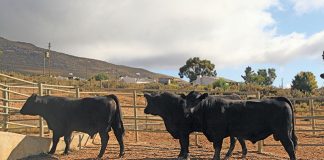
Cattle, sheep, goats, horses, donkeys, pigs and other livestock have certain physical characteristics that can be used to identify individuals on sight. In an objective description that enables a second or third party to positively identify the animal, there is also a cost implication in record keeping or description, used in combination with other criteria, as back-up.
The first and most conspicuous characteristic is coat colour. In some cases an individual can be identified immediately from some distance away, especially if the difference is as noticeable as a Black Angus or Drakensberger in a herd of Charolais.
Although difficult to quantify definitively, colour can speed up the search for a conspicuously coloured animal, although other characteristics may be necessary to confirm the identification.
Read: Know your cattle: Afrikaner
Colour as a basis for individual identification becomes more difficult in a group of uniformly coloured animals such as Bonsmara cattle (red), Angus or Drakensberger cattle (black) or Kalahari Red goats (red), and even in bi-coloured breeds such as Holstein, Simmentaler, Hereford and Pinzgauer cattle or Boer Goats. In wool sheep, colour is of practically no use; the colour is generally a uniform dirty white, the intensity varying with the length of the wool and the nature of the environment.
Hide patterns
An extreme and interesting example is that of Nguni cattle. The Nguni is the traditional cattle breed of the Zulus. Cattle are a strong feature in Zulu culture and considered a measurement of wealth: the more cattle a man owns, the wealthier he is seen to be. To safeguard cattle against wild animals and raiding tribes, at night they were traditionally placed in a kraal at the centre of the village surrounded by the huts.
Nguni hides come in a bewildering assortment of rich colours and patterns. The more common colours are black, white, brown and in less common examples, a combination of all three and/or dun (also known as yellow). The great variation in this indigenous Southern African breed is believed to be based on the need of owners to identify their cattle, hence the many Zulu names for the different colour patterns and shape of the horns. Each hide pattern has a name closely associated with an animal, bird, plant or other natural object or phenomenon. An animal may be described by the pattern of its hide.
The naming system and the various names and types of objects and features in the herder’s everyday environment, documented in The Abundant Herds by Marguerite Poland and David Hammond Tooke, are no doubt the basis of this rich legacy. A herder, spending most of the day with his charges would get to know each animal in the herd and, even if he could not objectively describe an individual to the degree of detail required in a modern court of law, would quickly pick a specific animal out of a hundred others.
Read: Know your cattle: Drakensberger
The same colour patterning and variation is found in indigenous sheep and goats, especially the Damara and Pedi sheep and the Indigenous Veld Goat, in which the same identification principles as for Nguni cattle apply. In some breeds, the colour may change as the animal matures. A good example is found in Romagnola cattle, where the reddish colour of the newborn calf changes to an ivory colour as the animal matures.
Decades ago, in certain horse breeds such as the Arabian, the colouration of the foal was carefully noted and its description, along with illustrations/photos, was attached to its registration certificate as a positive means of identification. If the base colour changed as the horse matured, the position of ‘stars’ (patches of contrasting colouration) remained fixed. Even so, the genetic basis for colour in livestock is extremely complex and still not completely understood.
Image and print ID
With advanced computer programmes such as those enabling automatic facial recognition, colour pattern recognition software is not beyond imagining. If a reference image was available as a match, a specific animal could be positively identified. But this also means that a farmer must have a reference picture collection of all his animals.
Although this is a mammoth undertaking, it is possible; Ben Fyfer of the Bhetjane Nguni Stud near Vryburg has been doing it for years and has an impressive collection of colour photos of all the animals born on his farm. However, a word of caution: should the body position of the animal to be identified differ too much from that of the animal in the reference collection photo, the degree of confidence of identification might suffer. It would also not work with an equal degree of confidence on all animals, as it will be more accurate with distinctively-coloured animals and less so with uniformly coloured animals that may even be misidentified.
In any case, there are more practical systems, such as nose print (muzzle prints) recognition. Muzzle patterns of cattle are the uneven patterns on the surface of the skin of the nose. These patterns are distinctive and cannot be modified. The muzzle print is commonly used for sale and exhibition sheep and cattle. In Japan, in registering beef cattle for breeding and marketing, the muzzle pattern is lifted in black ink on a piece of white paper before the animal reaches the age of 4 months and then again at over 14 months.
Read: Breeding indigenous Ngunis in the Piketberg
More than 3 million beef cattle have been registered in this way at the Wagyu Registry Association in Kyoto, since 1948. The characteristics, as distinctive as a human fingerprint, are consistent over time. A print is taken by restraining the animal, and placing a small amount of ink on its dried nose. The ink is then transferred to an index card, supported by a wooden block or stiff backing, pressed against the nose.
Problems associated with nose printing include using too much ink, moisture build-up on the nose and sudden head jerking, which can result in a smeared and unreadable print. Although this method has proven to be highly accurate, its major disadvantage is that it is difficult and time-consuming taking up to 6 minutes per animal.
The advantage of the abovementioned systems is that they are non-intrusive and ‘animal friendly’. The disadvantage is that they take time and do not meet the needs of a modern commercial livestock industry or of livestock identification legislation.
Next week we look at some systems that do.
Source: Minagawa, H., Fujimura, T., Ichiyanagi, M., and Tanaka, K. 2002. Identification of beef cattle by analyzing images of their muzzle patterns lifted on paper. Publications of the Japanese Society of Agricultural Informatics, 8, pp 596-600.













